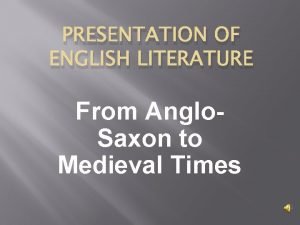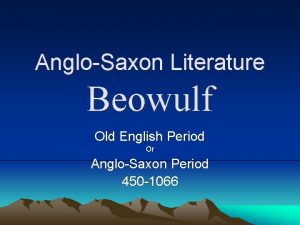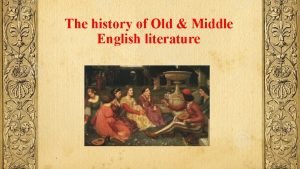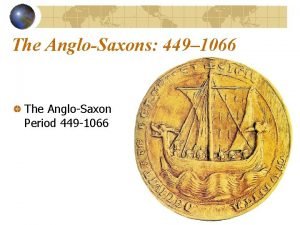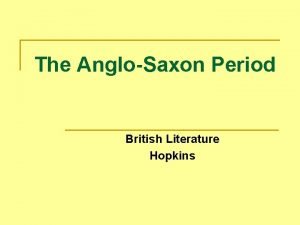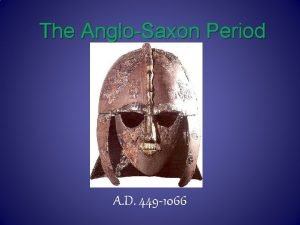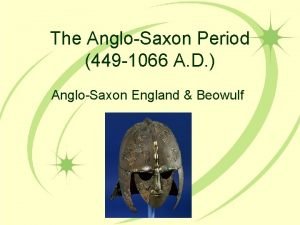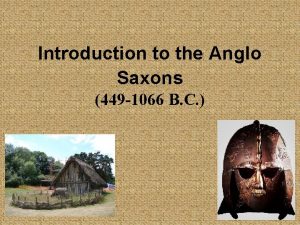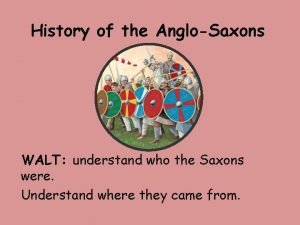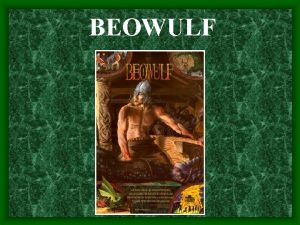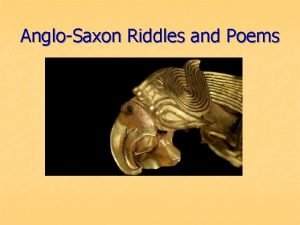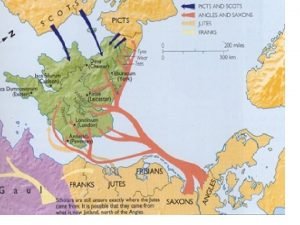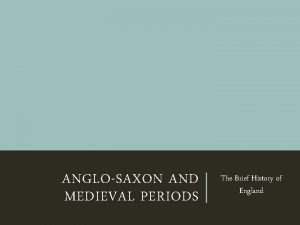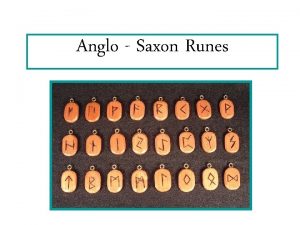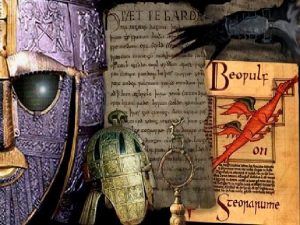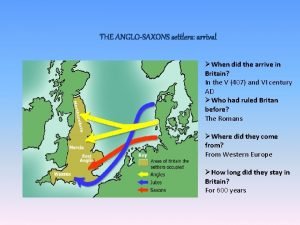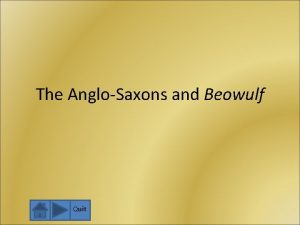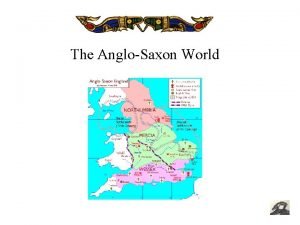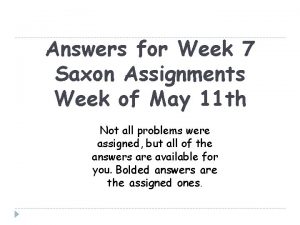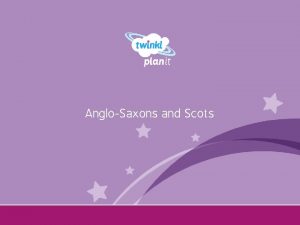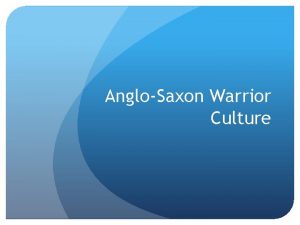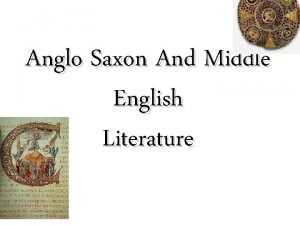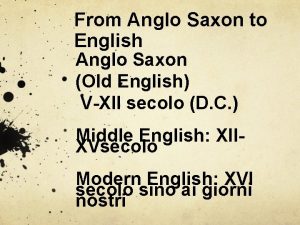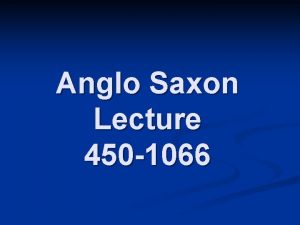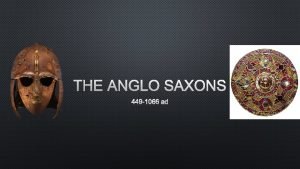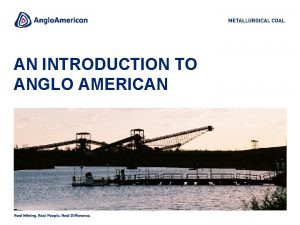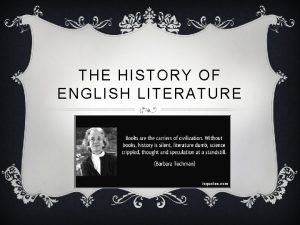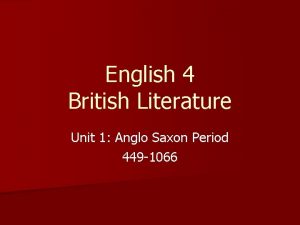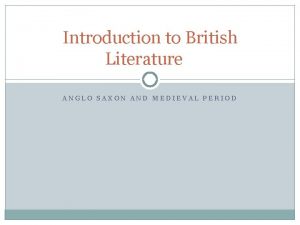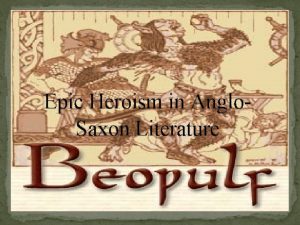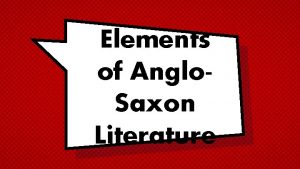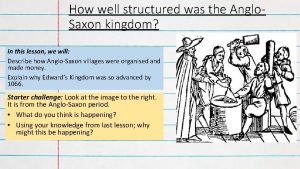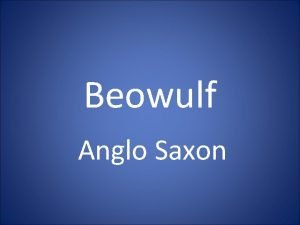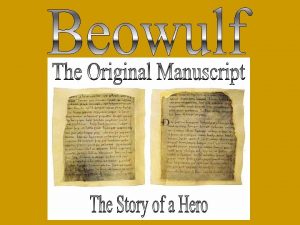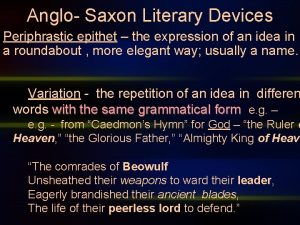PRESENTATION OF ENGLISH LITERATURE From Anglo Saxon to

























- Slides: 25

PRESENTATION OF ENGLISH LITERATURE From Anglo. Saxon to Medieval Times

From the Celtic People to 1066 � the importance of Latin writers

The Iberians � They lived in wooden huts and were artisans, in fact they produced stone and metal objects. They were also farmers and they started the breeding. � The Iberians reached the first stages of civilization during the Bronze and the Iron ages. In the Bronze Age they built a huge temple called Stonehenge.

Stonehenge � � This temple is built about 2500 B. C. between bronze and iron ages The stones were dressed using sophisticated techniques and erected using precisely interlocking joints, unseen at any other prehistoric monument. There are many theories about this site , for example : a coronation place for Danish kings, a Druid temple, a site for predicting astronomical events, a place where ancestors were worshipped or a cult centre for healing. Today, the interpretation of Stonehenge which is most generally accepted is that of a prehistoric temple aligned with the movements of the sun. Today this monument is a most important archeological site

The organization of Celts tribes � These were called the Celts, who imposed them selves on the Iberians and had a more sophisticated cult ure. They works some types of metal to create armaments. They were organized in tribes and clans and each tribe has a king and it was composed by two social classes: the farmers and the nobles. The Celts were pagans and believed in different gods and the religious,

The Romans � After the Celtics tribes in England arrived the Romans. They civilized the South and East of Britain in fact London (lat: londinium) in this time began a great commercial centre. The economic basis of Britain was agriculture; there were also minor industries and mines, especially lead mines.

The Hadrian’s Wall � � Hadrian's Wall (Latin: Vallum Aelium ) was a defensive fortification in Roman Britain, begun in AD 121 during the reign of emperor Hadrian. In addition to its military role, gates through the wall served as customs posts. A significant portion of the wall still exists and can be followed on foot along the Hadrian's Wall Path. It is the most popular tourist attraction in Northern England was made a UNESCO World Heritage Site in 1987.

The germanic peoples � � After the Romans in Britain arrived Germanic invaders like the Angles, Saxons and Jutes that imposing their laws, language and customs in fact the name England derives from the Anglo-Saxon Engla land, meaning “land of the Angles”. The name Saxon derives from seax, sax or sahs (a short sword) and means “swordsmen The name Angles derives from the shape of the district that they came Angeln from ‘’angul’’(hook) They divided the island in to seven kingdoms(northumbria , Kent, Essex, Sussex , Wessex ,

Danes peoples � � � The Danes are originated from Scandinavia and invaded England between ninth and tenth centuries . The economic and political basic of society was constituted by freeman who owned the land they cultivated and whose social status was far superior to that of most European peasants at the time. The most important institution was the Althing a General Assembly that had function of tribunal and elects the kings.

Danes gods � � � � Before the Danes ’ s conversion to Christianity, they practicing the polytheism and believed in a number of major or minor gods like: Sol that she leads the solar chariot she has dedicated the sunday Màni that he leads the lunar chariot she has dedicated the Monday Tìr: he represents the god of war. He has dedicated the thusday. Odin he is the father of all gods. He has dedicated the Wednesday Thor he is the god of lightning. He has dedicated the Thursday Freyja she is the god of love and seduction. She has dedicated the Friday Sataere he is the god of evil and bad things. He has dedicated the suturday. Sataere is the old name for Loky


From Edward the confessor to Henry II � � � The last saxon king was Edward the confessor. After his death William duke of Normandy claimed the throne of england , but Harold of Wessex attacked William on october 14° 1066 near Hastings because he wanted the throne but he lose and died. In the 100 years after the death of William there were four kings : William II’’Rufus’’, Henry I Stephen and Henry II.

The feudal system

The role of women in the feudal system � Peasant women’s performed endless labor around the home and often out in the fields. Young peasant girls learned practical household skills from their mothers , while daughters in rich households were educated by tutors. But through the economic contribution women made, this was essential to the survival of the peasant household.

When noble men or kings were gone to war, the women toke place for them and were the leaders in organizing the defense.

Peasant women worked in fields helping the men support the house hold, and bring more money.

Women also were in charge of the house and young girls learned to do things and help out around the house before taken to work in the fields.

The Magna Charta � � � Magna Charta was a charter issued by King John Lackland on 15 June 1215 to negotiate a peace between the unpopular King and a group of rebel barons The magna charta was created because Jonh oppressed the barons and the clergy with excessive taxes. The consequences were: the king has less power and the barons and the clergy has more power.

The Hundred Year’s war � After the disaster of his father, Edward III want to transform the kingdom of England in to a one most formidable military power in Europe. He started the HUNDRED YEAR‘S WAR against France , in order to defend his French territories and to claim the vacant throne of France. The war broke out in 1337. The war after a lot peaces finished with the victory of France in the 1453.

The wars of two roses � After the Hundred year's war in England begun a series of civil wars between the house of Lancaster and the house of York to conquer the throne. The war knew as the wars of two roses because the emblems of these families were two roses. The war broke out in 1455 and finished in 1485 when Henry VII Tudor was crowned king.

The black death � During the Medieval period the plague went by several names, the most common being "the Pestilence" and "The Great Mortality". Theories about the cause of the disease were numerous, ranging from a punishment from God to planetary alignment to evil stares. Not surprisingly, many people believed that the horrors of the Black DEATH signaled the Apocalypse, or end of time. Others believed that the disease was a plot by Jews to poison all of the Christian world, and many Jews were killed by panicked mobs.

Pagan group � � The pagan group can be considered a truly national product, however since it contains elements common to Germanic history as well. Anglo-Saxon pagan poetry was originally only oral. This poetry is generally divided into two subgroups : epic and lyric. The oldest pagan epic script is Beowulf

Beowulf � This poem consist of two stories unified by the same hero; the first presents Beowulf an Scandinavian prince going to help Hrotgar to defeat a monster called Grendel. The second tell about Beowulf in old age when as been king of Geats and describes Beowulf’s fatal battle against a dragon.

Christianity group � � The Anglo-Saxon Christian prose was at first in Latin. The most important authors were Bede(673 -735 B. C) and King Alfred. Bede was known for his work: Historian Ecclesiastica Gentis Anglorum, that was an important source of information on Anglo. Saxon. King Alfred translated some write from Latin and he write Anglo-Saxon Chronicles.

CREDITS This work was made by: � Gioele Ortoleva � Vito Speciale � Samuele Bilello
 The old english period
The old english period Old english literature presentation
Old english literature presentation Introduction to anglo-saxon literature beowulf
Introduction to anglo-saxon literature beowulf Old english period historical background
Old english period historical background Anglo saxon timeline
Anglo saxon timeline Anglo-saxon poetic records
Anglo-saxon poetic records Anglo-saxon period
Anglo-saxon period Anglo saxon period
Anglo saxon period Anglo saxons alphabet
Anglo saxons alphabet Anglo.saxon meaning
Anglo.saxon meaning Anglo saxon passport
Anglo saxon passport Geatland
Geatland Anglo saxon riddle
Anglo saxon riddle Northumbria present day
Northumbria present day Anglo-saxon feudal system
Anglo-saxon feudal system Anglo saxon runes numbers
Anglo saxon runes numbers Kennings and alliteration
Kennings and alliteration Anglo saxon days of the week
Anglo saxon days of the week Sxons
Sxons Anglo saxon history timeline
Anglo saxon history timeline Anglo saxon homeland
Anglo saxon homeland The anglo-saxon period 449 to 1066 answers
The anglo-saxon period 449 to 1066 answers Anglo-saxon jewelry
Anglo-saxon jewelry Lof anglo saxon
Lof anglo saxon Code of comitatus
Code of comitatus Caesura anglo saxon
Caesura anglo saxon

